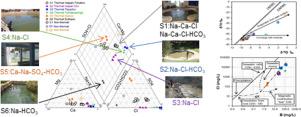Geothermics ( IF 3.9 ) Pub Date : 2021-07-12 , DOI: 10.1016/j.geothermics.2021.102176 T.A.K. Martínez-Florentino 1 , M.V. Esteller-Alberich 1 , J.L. Expósito 1 , E. Domínguez-Mariani 2 , J.I. Morales-Arredondo 3

|
This study was aimed at investigating the hydrogeochemical and isotopic characteristics of low-temperature hydrothermal springs in six study sites located in the eastern portion of the Trans-Mexican Volcanic Belt, in order to evaluate the source of the thermal water, rock-water interactions, and reservoir temperature. In addition, based on this, possible similarities and differences among these thermal springs were explored. Samples of thermal waters (12 samples) and non-thermal waters (6 samples) were collected during dry and rainy seasons. Stable isotopes (18O, 2H) as well as major, minor, and trace ions were analyzed for, and saturation indices and reservoir temperatures were estimated. Thermal water temperatures ranged from 33 to 55°C and the pH was slightly acid (and slightly basic in only one case). The electrical conductivity ranged widely, from 0.2 to 27 mS/cm, although most samples had > 8 mS/cm. Using a Piper diagram, three hydrochemical facies were identified: Na-Cl, Na-Ca-SO4-HCO3, and Na-HCO3. The notable minor and trace elements and ions were B, Li, As, and F− . δ18O and δ2H values plot very close to the meteoric water line, although samples from three of the study sites showed a possible isotope exchange between water and minerals at high temperatures. By estimating reservoir temperatures using solute geothermometers and saturation indices, it was possible to determine similarity among the values obtained (90 to 190°C). These data indicate that the hydrochemistry of the thermal waters reflects a water source that is related to geothermal brines in some cases, and with the mixing of a thermal fluid and a recently infiltrated water in other cases, as well as water-rock interactions (mostly with silicates) and carbonate precipitation.
中文翻译:

跨墨西哥火山带东部温泉的水文地球化学和地球测温
本研究旨在调查位于跨墨西哥火山带东部的六个研究地点的低温热液泉的水文地球化学和同位素特征,以评估温泉水的来源、岩水相互作用、和水库温度。此外,在此基础上,探讨了这些温泉之间可能存在的异同。在旱季和雨季采集了热水(12 个样品)和非热水样品(6 个样品)。稳定同位素 ( 18 O, 2H) 以及主要、次要和痕量离子进行了分析,并估计了饱和度指数和储层温度。热水温度范围为 33 至 55°C,pH 值略呈酸性(仅在一种情况下略呈碱性)。电导率范围很广,从 0.2 到 27 mS/cm,尽管大多数样品 > 8 mS/cm。使用派珀图,确定了三种水化学相:Na-Cl、Na-Ca-SO 4 -HCO 3和 Na-HCO 3。值得注意的微量元素和离子是 B、Li、As 和 F -。δ 18 O 和 δ 2尽管来自三个研究地点的样本显示高温下水和矿物质之间可能存在同位素交换,但 H 值非常接近大气水线。通过使用溶质地温计和饱和度指数估算储层温度,可以确定获得的值(90 到 190°C)之间的相似性。这些数据表明,热水的水化学反映了在某些情况下与地热卤水有关的水源,在其他情况下与热流体和最近渗透的水的混合以及水-岩石相互作用(主要是与硅酸盐)和碳酸盐沉淀。



























 京公网安备 11010802027423号
京公网安备 11010802027423号